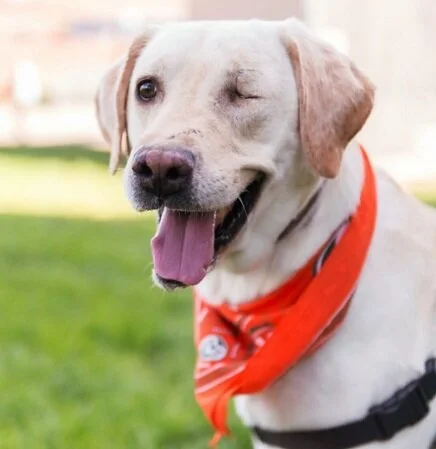Enucleations
There are several conditions of the eyes, which can be painful or blinding. Although the goal of a veterinary ophthalmologist is to try to save eyes and vision, wherever possible, sometimes removal of an eye (enucleation) is necessary. Some possible reasons for removal of an eye include uncontrolled glaucoma (increased intraocular pressure), a tumor inside the eye, or severe trauma to the eye. Although this can seem like a drastic option, enucleation is a relatively common procedure.
If you have been referred to a veterinary ophthalmologist for evaluation, they will first examine your pet to determine what may be going on. If your pet is diagnosed with a vision threatening or painful condition, treatments options may be available to try to preserve the eye. Alternatively, you may have been referred to a veterinary ophthalmologist to discuss enucleation. If it is determined that there are not viable treatments available, then enucleation may be recommended. Enucleation can resolve a painful condition and the eye can be submitted to a pathologist for evaluation, which can have prognostic value.
As mentioned above, an enucleation is the removal of the eye itself, as well as the upper and lower eyelids and the 3rd eyelid (also called the nictitating membrane). Your pet will be anesthetized, the fur clipped from around the eye and the eye will be surgically removed. The orbit (bony surrounding socket of the eye) can be left empty or a silicone orbital prosthesis may be placed. An orbital prosthesis is not recommended for cases with concern about infection or cancer. The remaining eyelid skin will then be carefully stitched closed. After surgery, there may be some swelling and bruising of the surgical site, but this will resolve with time. Your pet will go home with an Elizabethan collar, to protect the surgical site while it heals. The skin sutures are usually removed 10-14 days after surgery. If an orbital prosthesis was not used, over time, the area of eye removal may look sunken, although this is not an issue for your pet!
Since an enucleation is typically performed in blind or painful eyes, most pet owners find that their pets tolerate removal of the eye very well and are back to acting normally in a matter of days. In fact, removal of the eye can actually improve your pet’s quality of life.
In some cases, there may be alternative options to enucleation, such as an intrascleral prosthesis (an implant inside the eye itself) or an intravitreal injection (medication injected inside the eye to control glaucoma). For more information please talk to your veterinarian or find a veterinary ophthalmologist near you.

